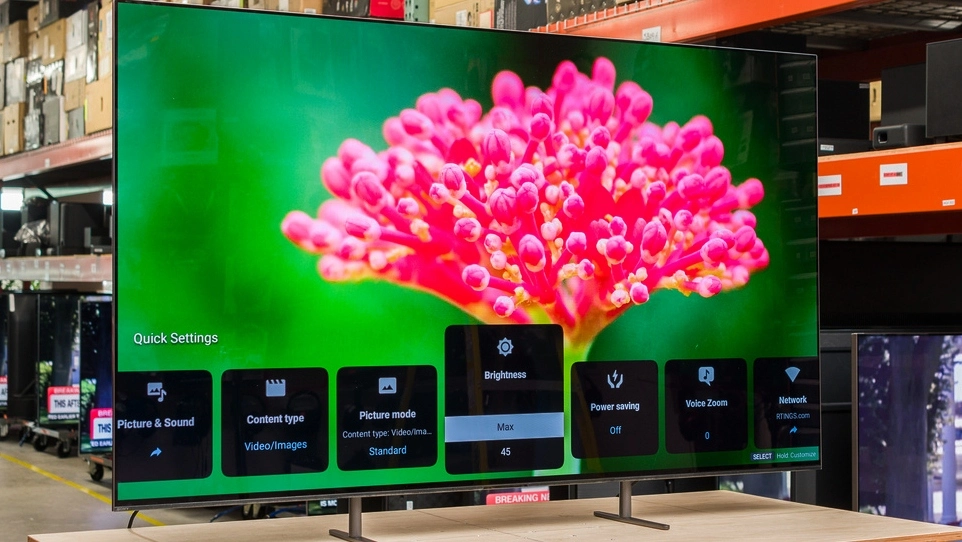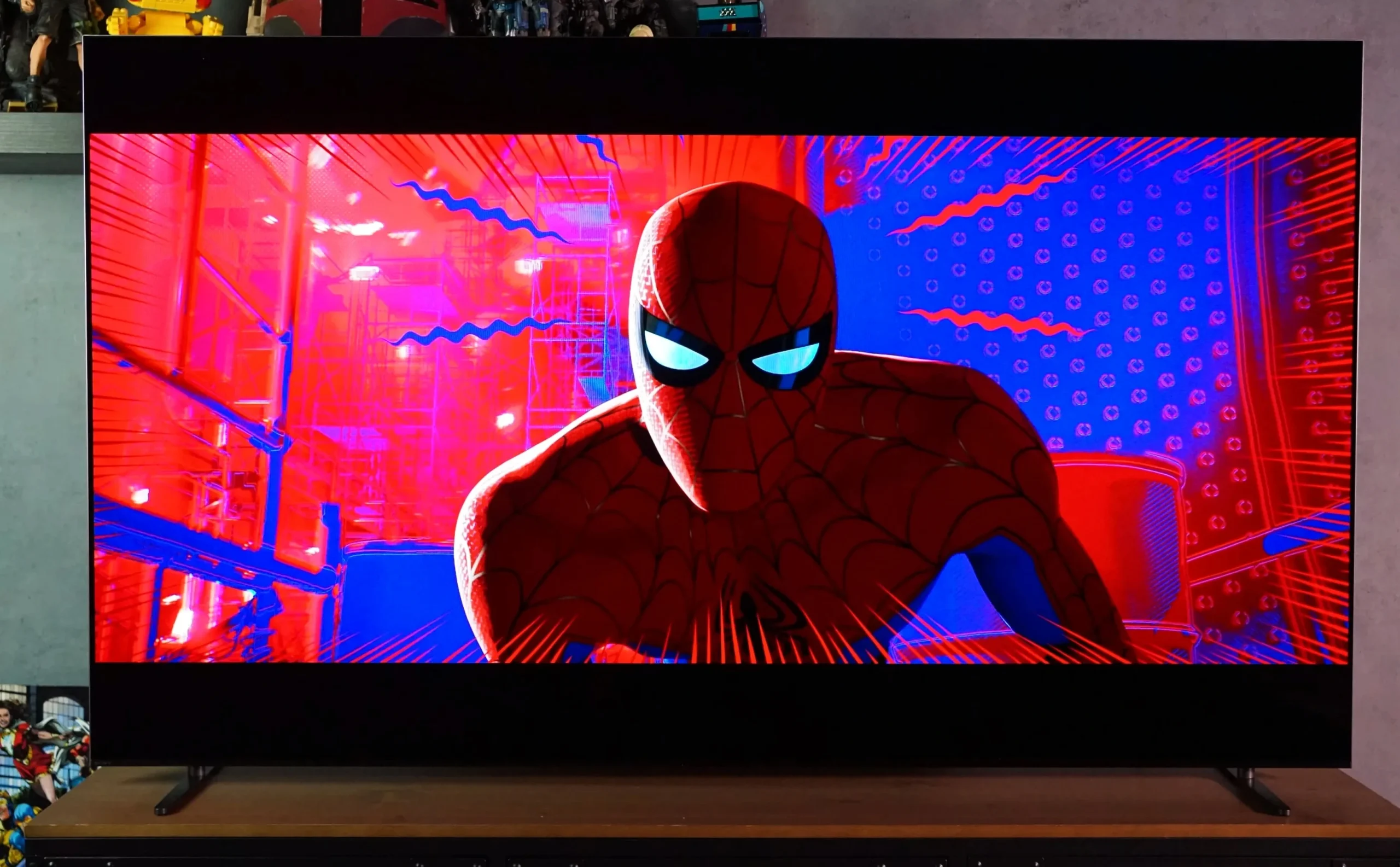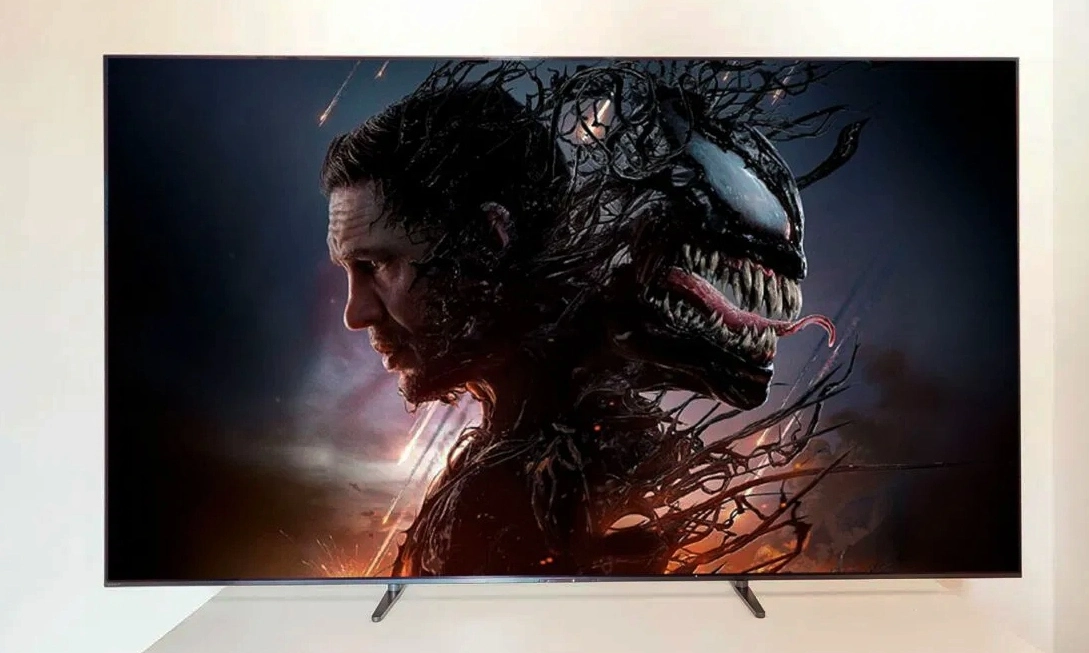The new 65-inch Sony Bravia 8 (65XR80) Smart TV has a traditional OLED panel, brighter and with more settings for total control of the image.
We recently tested a high-end Sony Smart TV, the Bravia XR A95L model, and it is one of the best OLEDs I have tested so far. I thought, at the time, that there is not really much more that can be done with this type of panel, taking into account the refresh rate, brightness and contrast levels.
I was wrong because Sony has surprised us again with the generation for 2024 and 2025, specifically with this new Sony Bravia 8, a Smart TV with an OLED panel that improves one of the most important details, the brightness level.
I have had the opportunity to test one of the latest Sony Bravia 8s for several weeks, specifically the 65-inch model, although it is also available in 55 and 77 inches.
Although Sony is one of the most important brands in the world of televisions, we cannot deny that Samsung and LG are there in the premium range, with more and more competitors such as TCL or Hisense, who are pushing their large televisions and organic light-emitting diode (OLED) panels or derivatives.
What has Sony been able to improve in a single year in a Smart TV that was already pretty good? Is it worth paying the 2,000 euros that the 55-inch model costs, or the 2,500 euros for the 65-inch one?
Among the most important changes is that its 4 HDMI ports are now compatible with HDMI 2.1 at 120 Hz, so no incompatibilities if you already have two in use. In addition, Sony has updated the Bluetooth to version 5.3 and, most importantly, increased the brightness compared to the previous generation A80L.
Minimalism and with legs that are highly customizable in height and position

For years now, talking about TV design has been unnecessary, to say the least. Why? We have reached a level of thinness and such small frames that it is rare to find a TV that is not ultra-thin and with such small frames that they are hardly visible.
The Sony Bravia 8 has that effect where the whole screen is almost the entire front and that is the least you should expect in a high-end Smart TV like this one.
But the design of a TV is more than just the front, it’s also the back and how it’s used. For example, the stand.
In this case the stand is two metal legs. These legs are adjusted with two screws and you can choose different positions. Either you put the legs on the outside (as I have done and you can see in all the photos) or more centered.
Sony will have done their research and, honestly, I don’t think anything will happen if you put the legs in the center, but it gives a terrible feeling of instability. That’s why I prefer to put the legs at the ends.
In addition to these two positions, you can choose two heights. The lowest one as in the photos, or one that raises it about 5 centimeters. The latter is the best position if you want, for example, to place a sound bar in front of the TV.
Of course, it has the corresponding VESA mounts for wall mounting.
The back is completely and utterly boring. And that’s perfect because you’re going to see the back when you assemble it and when you’re going to change it. On the left side we find all the connections and on the right side, again, the connection for the power cable. Call me a perfectionist, but they could have put the power cable on the same side as the connections and thus have everything on the same side.
Access to the ports on the side is good, although not ideal if you want to put the TV on a wall. You will have to manage the cabling well to run it through the wall or through a duct towards the TV cabinet to make it less visible.
Of course, include panels to hide all those connections and, as far as possible, to keep out the dust.
It includes two remote controls, the big one with a thousand standard “old-fashioned” buttons and the one you should use, the more compact remote that Sony allows you to charge via USB-C. Not only is it perfect in size and weight, the remote control has backlighting, a rare feature that I didn’t know was so necessary until you try it.
It’s a small detail, but it’s a detail that wins you over. Many times, at night or in the dark, you look for a button and if the screen is off or with low brightness, it is difficult to find it. The backlight solves this problem, which as I say is a small detail, but Sony is winning points based on small details.
I’m not a big fan of buttons with shortcuts to streaming services that I don’t use and that Sony or Google won’t let me customize on Google TV, but there’s always an app for that, like Button Mapper.
An OLED panel that’s even brighter
The big difference compared to the 2023 generation is the increase in brightness, which in itself, on an OLED panel like this one, was already quite good. The increase in brightness is minimal, but noticeable. But more importantly, when you’re watching standard definition content, without HDR, Sony improves the brightness, slightly, but it’s noticeable.
But, apart from the brightness improvement, which I must remember for the millionth time is a minimal increase, I don’t notice an improvement in other characteristics with the naked eye. Not in contrast or even in an improvement in the rendering of standard definition videos to 4K.
The contrast is perfect, the image quality in 4K, the HDR content looks great and it represents black colors with great depth. As it is an OLED panel and has no local dimming, there is no white halo effect in dark areas.
Viewing angles are something to take into account. Not only do you have excellent image quality even at narrow angles, but there are also fewer reflections, although this is still a problem with glossy panels like this one.
In gaming, testing with a PlayStation 5 and The Last of Us 2, with gaming mode activated, I hardly notice any difference with the calibration for movies, although it does tend to increase the brightness in light and white areas.
As a new feature, although they already had the certified calibration mode for Netflix, the TV will now calibrate itself automatically for Amazon Prime Video content according to how the film directors believe it should look.
More customization options on Google TV
Sony has been using Android as an operating system for years and it is, in my opinion, the best platform for televisions because it integrates Google’s Chromecast and Apple’s AirPlay 2. This way, not only do you have many Android applications on your television, you can also send content wirelessly from your mobile, whether it is an iPhone or an Android.
Although there are many brands that use Android as an OS, including Sony’s relatively new Google TV, the Japanese have been given the opportunity to improve the interface with new shortcuts to access picture and sound settings.
You can access them from the settings menu or from the new floating menu that allows you to adjust, among other options, optimization for a specific HDMI port, panel refresh or improvement of the ambient mode for when there are light sources that create reflections.
Having this settings menu is pretty good for expert users who can remember that this menu exists. In all the weeks that I have been testing this TV, I think I only accessed it a couple of times and I think it is a feature that will go completely unnoticed by the vast majority of users.
Sony includes some applications pre-installed, such as Sony Picture Core (formerly known as Bravia Core), which is its platform for streaming films produced by Sony and specially optimized for its televisions. You have free access to around 20 films that you can rent and watch without any problems and, boy, does the quality show. Films like Spider-Man: Into the Spider-Verse, so colorful and one of the best to take advantage of HDR, look spectacular.
It continues to maintain excellent sound quality without the need for bars or extras
My biggest problem with Smart TVs for years has been how much they forgot about sound in the quest for the thinnest possible TV. And since there wasn’t room for big speakers that could move a lot of air, the sound was really disappointing.
This has been changing for several years now thanks to the fact that at least some brands are putting more emphasis on better quality speakers. In the case of Sony, its high-end Smart TVs include one of those tricks that seems incredible but works.
As in previous generations, this Sony Bravia 8 includes its Acoustic Surface Audio+ technology, which means that in addition to the two rear speakers, Sony includes a system that makes the screen vibrate and acts as a speaker. You will never notice the screen vibrating, but the reality is that you can tell that the sound quality is better than other TVs of this type, even of the same size.
In total it has a 50 W sound system with three actuators and two low-frequency drivers (10 W each).
The TV, without a soundbar connected, reaches a fairly high volume level, enough to disturb your neighbors and with enviable clarity. It is one of the few TVs I have tested in the last year that I still maintain that, although it is recommended, you will not need a soundbar.
Is the Sony Bravia 8

The new 65-inch Sony Bravia 8 (65XR80) Smart TV has a traditional OLED panel, brighter and with more settings for total control of the image.
We recently tested a high-end Sony Smart TV, the Bravia XR A95L model, and it is one of the best OLEDs I have tested so far. I thought, at the time, that there is not really much more that can be done with this type of panel, taking into account the refresh rate, brightness and contrast levels.
I was wrong because Sony has surprised us again with the generation for 2024 and 2025, specifically with this new Sony Bravia 8, a Smart TV with an OLED panel that improves one of the most important details, the brightness level.
I have had the opportunity to test one of the latest Sony Bravia 8s for several weeks, specifically the 65-inch model, although it is also available in 55 and 77 inches.
Although Sony is one of the most important brands in the world of televisions, we cannot deny that Samsung and LG are there in the premium range, with more and more competitors such as TCL or Hisense, who are pushing their large televisions and organic light-emitting diode (OLED) panels or derivatives.
What has Sony been able to improve in a single year in a Smart TV that was already pretty good? Is it worth paying the 2,000 euros that the 55-inch model costs, or the 2,500 euros for the 65-inch one?
Among the most important changes is that its 4 HDMI ports are now compatible with HDMI 2.1 at 120 Hz, so no incompatibilities if you already have two in use. In addition, Sony has updated the Bluetooth to version 5.3 and, most importantly, increased the brightness compared to the previous generation A80L.
Minimalism and with legs that are highly customizable in height and position.
For years now, talking about TV design has been unnecessary, to say the least. Why? We have reached a level of thinness and such small frames that it is rare to find a TV that is not ultra-thin and with such small frames that they are hardly visible.
The Sony Bravia 8 has that effect where the whole screen is almost the entire front and that is the least you should expect in a high-end Smart TV like this one.
But the design of a TV is more than just the front, it’s also the back and how it’s used. For example, the stand.
In this case the stand is two metal legs. These legs are adjusted with two screws and you can choose different positions. Either you put the legs on the outside (as I have done and you can see in all the photos) or more centered.
Sony will have done their research and, honestly, I don’t think anything will happen if you put the legs in the center, but it gives a terrible feeling of instability. That’s why I prefer to put the legs at the ends.
In addition to these two positions, you can choose two heights. The lowest one as in the photos, or one that raises it about 5 centimeters. The latter is the best position if you want, for example, to place a sound bar in front of the TV.
Of course, it has the corresponding VESA mounts for wall mounting.
The back is completely and utterly boring. And that’s perfect because you’re going to see the back when you assemble it and when you’re going to change it. On the left side we find all the connections and on the right side, again, the connection for the power cable. Call me a perfectionist, but they could have put the power cable on the same side as the connections and thus have everything on the same side.
Access to the ports on the side is good, although not ideal if you want to put the TV on a wall. You will have to manage the cabling well to run it through the wall or through a duct towards the TV cabinet to make it less visible.
Of course, include panels to hide all those connections and, as far as possible, to keep out the dust.
It includes two remote controls, the big one with a thousand standard “old-fashioned” buttons and the one you should use, the more compact remote that Sony allows you to charge via USB-C. Not only is it perfect in size and weight, the remote control has backlighting, a rare feature that I didn’t know was so necessary until you try it.
It’s a small detail, but it’s a detail that wins you over. Many times, at night or in the dark, you look for a button and if the screen is off or with low brightness, it is difficult to find it. The backlight solves this problem, which as I say is a small detail, but Sony is winning points based on small details.
I’m not a big fan of buttons with shortcuts to streaming services that I don’t use and that Sony or Google won’t let me customize on Google TV, but there’s always an app for that, like Button Mapper.
An OLED panel that’s even brighter

The big difference compared to the 2023 generation is the increase in brightness, which in itself, on an OLED panel like this one, was already quite good. The increase in brightness is minimal, but noticeable. But more importantly, when you’re watching standard definition content, without HDR, Sony improves the brightness, slightly, but it’s noticeable.
But, apart from the brightness improvement, which I must remember for the millionth time is a minimal increase, I don’t notice an improvement in other characteristics with the naked eye. Not in contrast or even in an improvement in the rendering of standard definition videos to 4K.
The contrast is perfect, the image quality in 4K, the HDR content looks great and it represents black colors with great depth. As it is an OLED panel and has no local dimming, there is no white halo effect in dark areas.
Viewing angles are something to take into account. Not only do you have excellent image quality even at narrow angles, but there are also fewer reflections, although this is still a problem with glossy panels like this one.
In gaming, testing with a PlayStation 5 and The Last of Us 2, with gaming mode activated, I hardly notice any difference with the calibration for movies, although it does tend to increase the brightness in light and white areas.
As a new feature, although they already had the certified calibration mode for Netflix, the TV will now calibrate itself automatically for Amazon Prime Video content according to how the film directors believe it should look.
More customization options on Google TV
Sony has been using Android as an operating system for years and it is, in my opinion, the best platform for televisions because it integrates Google’s Chromecast and Apple’s AirPlay 2. This way, not only do you have many Android applications on your television, you can also send content wirelessly from your mobile, whether it is an iPhone or an Android.
Although there are many brands that use Android as an OS, including Sony’s relatively new Google TV, the Japanese have been given the opportunity to improve the interface with new shortcuts to access picture and sound settings.
You can access them from the settings menu or from the new floating menu that allows you to adjust, among other options, optimization for a specific HDMI port, panel refresh or improvement of the ambient mode for when there are light sources that create reflections.
Having this settings menu is pretty good for expert users who can remember that this menu exists. In all the weeks that I have been testing this TV, I think I only accessed it a couple of times and I think it is a feature that will go completely unnoticed by the vast majority of users.
Sony includes some applications pre-installed, such as Sony Picture Core (formerly known as Bravia Core), which is its platform for streaming films produced by Sony and specially optimized for its televisions. You have free access to around 20 films that you can rent and watch without any problems and, boy, does the quality show. Films like Spider-Man: Into the Spider-Verse, so colorful and one of the best to take advantage of HDR, look spectacular.
It continues to maintain excellent sound quality without the need for bars or extras
My biggest problem with Smart TVs for years has been how much they forgot about sound in the quest for the thinnest possible TV. And since there wasn’t room for big speakers that could move a lot of air, the sound was really disappointing.
This has been changing for several years now thanks to the fact that at least some brands are putting more emphasis on better quality speakers. In the case of Sony, its high-end Smart TVs include one of those tricks that seems incredible but works.
As in previous generations, this Sony Bravia 8 includes its Acoustic Surface Audio+ technology, which means that in addition to the two rear speakers, Sony includes a system that makes the screen vibrate and acts as a speaker. You will never notice the screen vibrating, but the reality is that you can tell that the sound quality is better than other TVs of this type, even of the same size.
In total it has a 50 W sound system with three actuators and two low-frequency drivers (10 W each).
The TV, without a soundbar connected, reaches a fairly high volume level, enough to disturb your neighbors and with enviable clarity. It is one of the few TVs I have tested in the last year that I still maintain that, although it is recommended, you will not need a soundbar.
Is the Sony Bravia 8 worth it?

The Sony Bravia 8 is a spectacular television capable of displaying the best image quality in 4K and HDR10 content. In addition, the improvements to Google TV make it one of the best options on the market with this operating system.
Taking into account its features and design details, the 2,500 euros that Sony is asking for it is more than justified, as long as we bear in mind that we are talking about a high-end TV with an excellent OLED panel and sound system.
The problem with the Sony Bravia 8 is that if we compare it with the previous generation, such as the A80L from 2023, the improvement is very small. Which makes me think that it’s more worthwhile to find an older generation as long as you can find it on offer.
If you have a budget of between 2,000 and 2,500 euros to get the 55-inch or 65-inch model (let’s face it, 77 inches is an enormous size for the vast majority), it’s a good investment for the future that will hopefully last you at least 6 to 8 years.
worth it?
The Sony Bravia 8 is a spectacular television capable of displaying the best image quality in 4K and HDR10 content. In addition, the improvements to Google TV make it one of the best options on the market with this operating system.
Taking into account its features and design details, the 2,500 euros that Sony is asking for it is more than justified, as long as we bear in mind that we are talking about a high-end TV with an excellent OLED panel and sound system.
The problem with the Sony Bravia 8 is that if we compare it with the previous generation, such as the A80L from 2023, the improvement is very small. Which makes me think that it’s more worthwhile to find an older generation as long as you can find it on offer.
If you have a budget of between 2,000 and 2,500 euros to get the 55-inch or 65-inch model (let’s face it, 77 inches is an enormous size for the vast majority), it’s a good investment for the future that will hopefully last you at least 6 to 8 years.





